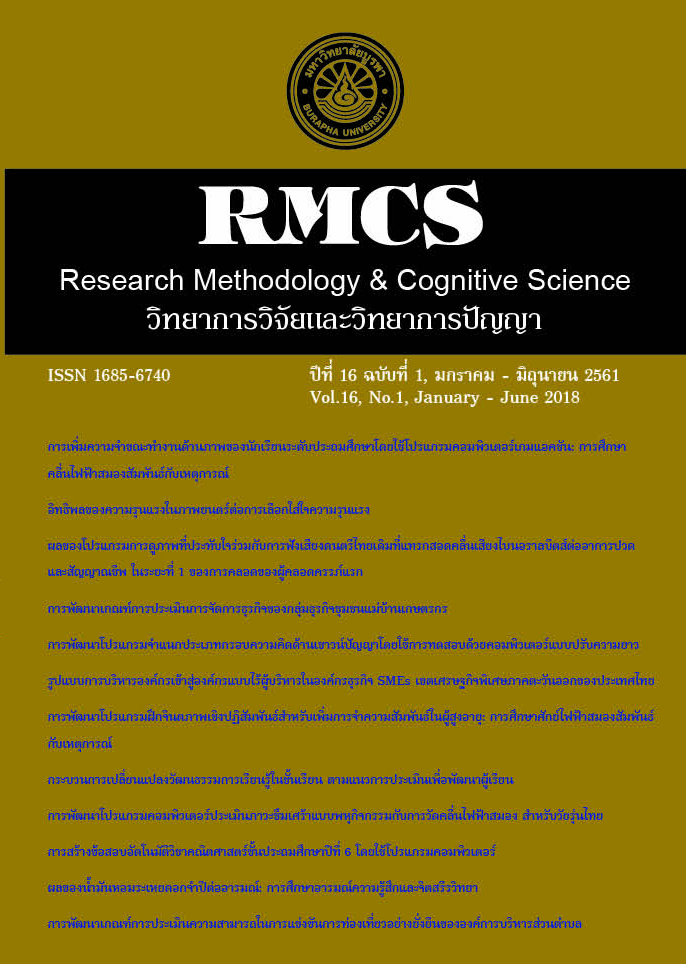The Model of Business Management to Become Non-Executive Organization of SMEs Business Unit in Eastern Special Economic Zone of Thailand
Main Article Content
Abstract
The research aimed to study the model of organization management to become a nonexecutive organization of SMEs in Eastern Special Economic Zone of Thailand. Qualitative research methodology used in the study consisted of in-depth interview conducted to experts and data analysis was done by using Delphi Technique for 3 rounds and the results of the data analysis were confirmed by focus group. The result shows the business management model for SMES to become a non-executive organization must have the following key features and characteristics: 1) The organization should have responsibilities with clear, fast, autonomous, flexibility, credibility, morality, good governance, and can be adapted and changed every time. 2) Using technology and innovation to manage the organization. 3) There should be decentralization of the organization in which employees can set their own style to work and can work and make important decisions freely with allowed to participate in business management and including mutual trust within the organization and within the team. 4) Performance measurement is effective, transparent, and verifiable, cost effective management requires planning and preparation of good strategies in terms of management and production of quality products and services. Focus on customers and stakeholders and leaders must have a vision and leadership for organization continues to grow and sustainable. 5) The organization should have a spiritual corporate culture, clear philosophy, and values, provision of good, honest, diligent, reliable services, effective communication both inside and outside the organization and good conflict management in the organization, create values and should value employees as human capital, create a teamwork culture which honors each other, equality and fairness.
Article Details
References
พูนเพิ่ม เสรีวิชยสวัสดิ์. (2558). การใช้รูปแบบขององค์การเสมือนจริงในธุรกิจอุตสาหกรรมบริการ. วารสารมนุษยศาสตร์. 22(2), 209-225.
พสุ เดชะรินทร์. (2560). องค์กร 4.0.เข้าถึงได้จาก http://www.bangkokbiznews.com/blog/ detail/640476
สำนักงานคณะกรรมการพัฒนาการเศรษฐกิจและสังคมแห่งชาติ. (2558). ภาวะเศรษฐกิจไทยไตรมาส 3 ปี 2558 และแนวโน้มปี 2558-2559.เข้าถึงได้จาก https://www.m-society.
go.th/article_attach/15636/18866.pdf
Bao, G. M. & Yang, J. (2004). The role of technological management in technological innovation: based on the enterprises in Zhejiang. Studies in Science
of Science, 22(5), 546-551.
Blanchard, O. (2007). Current account deficits in rich countries. IMF Staff Papers. Palgrave Macmillan Journals, 54(2), 191-219.
Buytendijk, F. (2006). Five key to building high performance organization. Business Performance Management Magazine, 4(1), 24-47.
Chatman, J. A., & Jehn, K. A. (1994). Assessing the Relationship between Industry Characteristics and Organizational Characteristics, How Different Can You Be. Academy of Management Journal,37(3), 522-553.
Chesbrough, H. (2010). Open services innovation: Rethinking your business to grow and compete in a new era. New York: John Wiley & Sons.
Dess, R., & McLaughlin, P. (1995). The new corporate architecture. Academy of Management Executive. Retrieved from http://dbonline.lib.cmu.ac.th/
abi/detail.nsp.
Eisenmann, T. R., Parker, G., & Van Alstyne, M. W. (2011). Platform Envelopment. Strategic Management Journal, 32(12), 1270-1285.
Erickson, T. J., Magee, J. F., Roussel, P. A., & Saad, K. N. (1990). Business Models and Technological Innovation. MITSloan review in Spring. New York: Massachusetts Institute of Technology.
Gladwell, M., Russell, B., Stirman, J., Pisoni, A., & Williams, E. (2016). Holacracy - How It Works. Spring City, Pennsylvania: HolacracyOne, LLC.
Hersey, P., Blanchard, K. H., & Johnson, D. E. (2001). Management of organization behavior: Leading human resources. (8th ed.). Englewood Cliffs, New Jersey: Prentice-Hall.
HPO center. (2016). High Performance Organization (HPO) Framework. Retrieved from http://www.hpocenter.com/hpo-framework/
Hsieh, T. (2015). Inside Zappos CEO Tony Hsieh’s radical management experiment that prompted 14% of employees to quit.Retrieved from http://www.businessinsider.com/tony-hsieh-zappos-holacracymanagement-experiment-2015-5
ICMA center. (2016). High Performance Organizations. Leading practice. Center for management strategies. Retrieved from www.icma.org/en/results/management_strategies/leading_practices/hpo
Jupp, V., & Younger, M. P. (2004.). A Value Model for the Public Sector. Retrieved from http://www.accenture.com.
Kaplan, R. S., & Norton, D. P. (2001). The strategy-focused organization: How balanced scorecard companies thrive in the new business environment. Harvard Business School Press.
Kim, J. & Bang, S. C. (2013). What are the Top Cultural Characteristics That Appear in High-Performing Organizations across Multiple Industries? Human Resources Management Commons. Student Works. ILR School site: Cornell University ILR School.
Lincoln, S. (2012). Empowerment: What does it mean to you? United nation social development network. Department of Economic and Social Affairs. Division for Social policy and Development.
Linder, J. C., & Brooks, J. D. (2004). Transforming the public sector. Outlook Journal, 6(10), 68-76.
Moller, C. (2012). Practical Leadership. Claus Møller Consulting. Labinah A/S. Retrieved from http://clausmoller.com/en/home/
Parsons, R. J. (1991). Empowerment: Purpose and practice principle in social work. Social Work with Groups: A Journal of Community and Clinical
Practice, 14(2), 7-21.
Pour, B. S. (2014). Analysis of the Impact of Information Technology and Perceived Organizational Justice on Employee Empowerment. Case Study: Payame Noor University of Kermanshah Province. Department of Educational Sciences, Payame Noor University, Tehran, Iran.
Rouse, M. (2015). Definition: Holacracy.Part of the Business terms glossary. Business term. Retrieved from www. whatis.techtarget.com/definition/ Holacracy.
Russo, S. (2014). Holacracy: pros and cons of a radical challenge to the traditional organization. Retrieved from http://www.hrreview.co.uk/hr-news/strategynews/holacracy-pros-and-cons-of-a-radicalchallenge-to-the-traditional-organisation/50404.
Sergiovanni,T. J. & Starratt, R. J. (1998). Supervision: A redefinition. (6th ed.). Boston: McGraw-Hill.
Torkkeli, M., & Tuominen, M. (2002). The contribution of technology selection to core competencies. International Journal of Production Economics,
77(3), 271-284.

